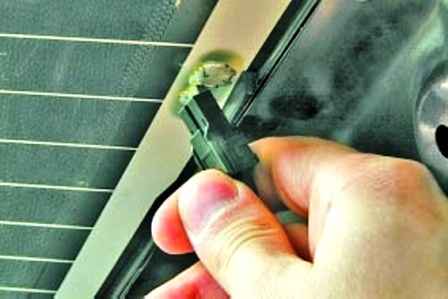The rear window heating element consists of horizontal conductive strips connected on both sides by vertical busbars
One bus is connected to the "+" of the on-board electrical network, the other - to the "mass" of the body
The power supply voltage of the electric heater is 12 V.
Power to the heating element is supplied through a fuse in the mounting block located in the vehicle interior.
If the glass surface remains uncleaned after turning on the electric heating, check the fuse.
If the fuse is good, check with a test lamp or voltmeter if there is supply voltage at the terminals of the glass heating element.
To do this, connect a test lamp (or voltmeter) to the "+" terminal of the electric heater and to "ground" (body).
If there is no supply voltage, check the wiring of the element power circuit and repair the problem.

Check that the connection between the heater contact and the power cable lug is secure. Clean the contact if necessary.
If the power circuit of the heating element is good, check the condition of its conductive strips.
The check is carried out with the engine running and the electric heating on.
Measure the voltage on all strips with a voltmeter in turn, connecting one lead of the voltmeter to the "mass" of the body, and the other in series to the conductive strips.
If the voltage measured by the voltmeter at the beginning and end of the strips is the same and approximately equal to the battery voltage, check the reliability of the contact of the "mass" wire of the heating element with the car body.
The voltage on the strip should decrease as the voltmeter connection moves away from the positive polarity bus of the element.
Stress must be measured at least in two places at the same distance from the axis of symmetry in order to exclude the possibility of missing a damaged area.
If you find a discrepancy in the readings on one of the strips, move the voltmeter wire lead along this strip until the voltage becomes zero.
A sharp decrease in voltage indicates a strip break at this point.
Mark the breakage on the outer surface of the glass with chalk or a glass cutter to repair the damaged area later.
One of the commercially available special kits can be used to repair the heating element.
Despite the fact that the kits are made by different manufacturers, their composition is approximately the same, all of them are supplied with instructions for use.
Typical workflow with these sets:
Remove a 6 mm strip from each side of the damaged area.
Wipe the damaged area with a clean cloth dampened with alcohol.
Stick on the glass at the point of damage to the strip repair adhesive tape or two pieces of ordinary adhesive tape on top and bottom of the repaired area, and the distance between the pieces of adhesive tape should correspond to the width of the conductive strip on the glass.
Mix the hardener thoroughly with the silver base compound.
If the hardener has thickened, place the package with it in hot water and wait until the hardener becomes liquid.
Apply the composition with a wooden spatula to the area to be repaired and remove the adhesive tape.
Install the heater at a distance of 25 mm from the damaged area and heat the composition for 1-2 minutes.
In some kits, the composition does not need to be heated: it polymerizes at room temperature.
If the strip is discolored after drying, apply a tinting iodine composition on it with a brush - the color of the strip will be restored.
After the iodine compound dries for 30 seconds, wipe off excess with a clean, lint-free cloth.
During the entire polymerization time of the repair composition, which lasts 24 hours, exclude any mechanical impact on the repaired section of the strip.
Turn on and test the rear window heating element.
If the contact has come loose from the bar, solder it with solder containing 3% silver and rosin paste as a flux in the following order.
Clean the solder area on the bar and on the contact.
Using a brush, apply a little rosin paste to the contact points and tires to be joined.
Apply a thin layer of solder to the pin.
Solder the contact to the bus, avoiding overheating of the parts to be joined.





